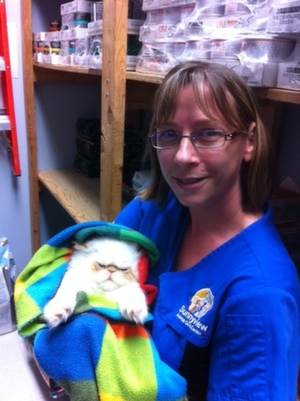
April 22, 2014 (reprint from Catalyst Council.org)
April 25th is Hairball Awareness Day, do you know how many hairballs per year are considered “normal”?
Friday is National Hairball Awareness Day, and the CATalyst Council, a national initiative comprised of animal health and welfare organizations working on behalf of cats, wants to inform cat owners about some misconceptions they may have about hairballs.
“There have been a lot of recent scientific studies about vomiting in cats and that it may be an indication of Inflammatory Bowel Disease, which can progress to cancer. I tell my clients that more than one or two supposed hairballs a year is not normal,” says Dr. Jane Brunt, CATalyst Council’s executive director and a feline veterinarian. “Frequently, when a cat vomits there is hair mixed in, so owners often assume that it is just a hairball—something they think is a normal occurrence. In fact, it may be a sign of a serious health issue. ” Hairballs are formed when a cat ingests fur through grooming, and the fur builds up in the stomach. Most of the time fur passes through the intestinal tract without any trouble. But if there is a problem with the gastrointestinal tract, such as inflammation, the fur can build up, and the cat will need to regurgitate it.
“What’s important for owners to know is that hairballs are not normal,” says Dr. Brunt. “The cat has developed a digestive tract that, when it is healthy and working correctly, can handle normal amounts of fur without problem. Even long haired cats should not develop more than one or two hairballs a year.”
Owners can help their cats avoid hairballs through frequent and regular brushing. This helps remove excess fur from cats before they ingest it. Brushing is also a great way to bond with your cat and can be used as a reward. “Brushing as a reward has two positive outcomes,” says Dr. Brunt, “First, your cat will have a lovely coat when properly brushed, and second, you may prevent your cat from becoming overweight if you are using brushing as a reward rather than treats.”
An owner should take their cat to the veterinarian if their cat vomits on a regular basis, has frequent hairballs or is repeatedly coughing (often interpreted as a “hairball”). Also, an owner should take their cat to the veterinarian if it is producing more than a few hairballs a year. This may be an indication of an intestinal disorder, a skin disorder or an allergy. Finally, even with no obvious signs of problems, regular veterinary visits for your cats at least once a year are the best way to keep them healthy and hairball-free.
For more information on hairballs, listen to Dr. Brunt’s AVMA Animal Tracks podcast on the subject here. The AVMA also has a kids’ video on hairballs here.
